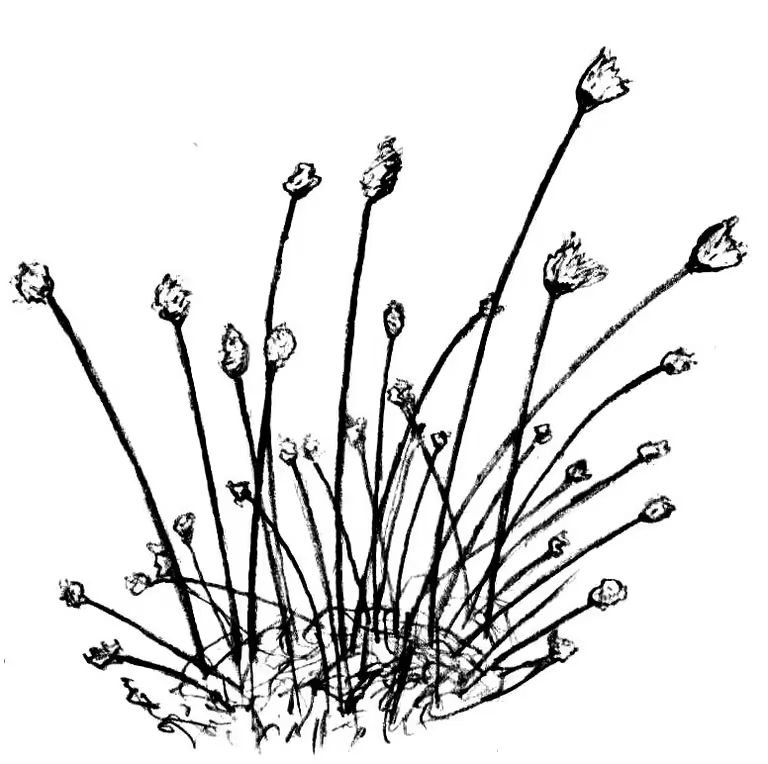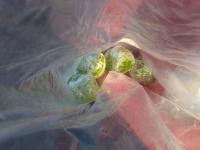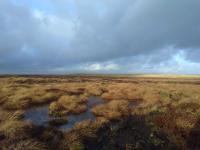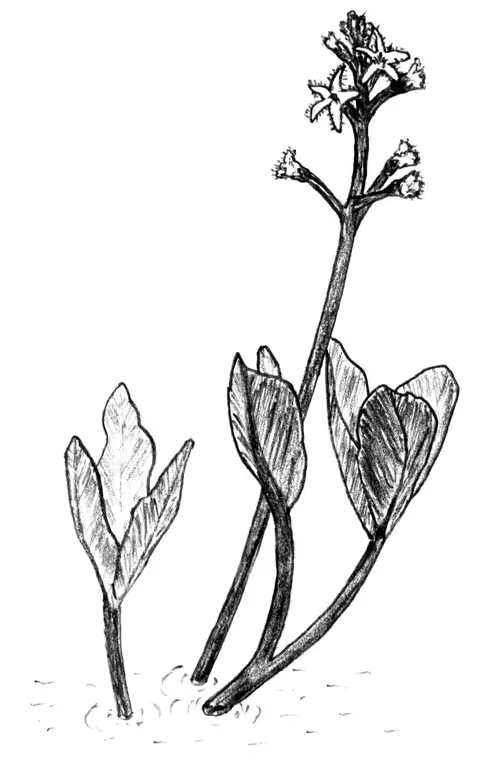For the Love of Sphagnum
Share this page

I’m always on the hunt for new ways to experience the moors of West Yorkshire, so when an opportunity came up to plant sphagnum moss for Moors For The Future I was keen to try it out.
We meet near Cock Hill mast above Hebden Bridge on a predictably wild day. It’s not raining yet, but the wind blows the car door shut every time I try to get out. Everyone else is donning all their layers at this point, so I follow suit, pulling on overtrousers and all my fleeces (four I think in total under the waterproof), then two pairs of gloves. I feel like Michelin man as I load up with sphagnum plugs from the main van – we each take four bags of 20 rolls. 80 plants I think, that’s easy. Not so fast, there are actually 20 plugs in each roll, so that’s 1600 plants that we’re expected to plant each day. There’s also the all important tool selection process. Everyone else already has their favourite stick – be it walking pole, sharpened branch or home-made plunging spike – and I plump for a lovely looking crook walking stick with a sharpened point that Keith has whittled.
We hump these bags on our back and set off across the peat hags and unbearable tussocks of the Great Grough Hole. I crossed this once before and said never again, yet here I am doing it while laden with a huge bag of moss. Keith and Mark grab the closest spots near Stake Hill, so the rest of us march on across the moor towards Warley Moor Reservoir and Nab Hill wind farm. At a long straight gully that is part of the water-harvesting allotment that was cut into this moor, Andy announces that this is fine planting and sets me and Miak to work on either side of it. He shows me how to plant a plug, how far apart they should be and what ground is good for them to take. I observe, “I see, it’s quality not quantity then” and he quickly retorts, “No, it’s both.”

And with that he is off across the moor and I’m left with my bags and Miak, who is already carefully marking out his area. I cross the drain and it is unsurprisingly wet, but I lose my usually-sure footing and nearly tumble into a pool with all my gear. I only rescue it by plunging my boot in and soaking half my leg with freezing bog water. So that’s why everyone else is wearing wellies!
I pull out the first roll of moss and start to unwrap the plastic sheath to reveal the first plug, which is actually just a cluster of strands loosely held together. I make a hole in the soft peat with the stick, then shove the moss into it as best I can before squeezing the peat back around it. Then move a couple of yards before repeating. It’s a little unsatisfying as some of the ground is so wet that the plug disappears almost completely into the bog and other parts are so grassy that the plug gets tangled with the grass and won’t go in at all. After a while I have completed my first roll, by which time a long string of plastic is billowing violently in the wind behind me, a kind of planter’s tail. I gather the plastic and shove it messily in my pocket and look across to Miak as I gather the next roll. He is busy, bobbing up and down almost robotically, as I reflect that I am only 20 plugs down with still 1580 to go. My hands are cold, wet and muddy and my back is already aching.

But I quickly get into a routine, working methodically across a 20m wide strip beside the gully. In my head I am mapping out the space to get the perfect spread of plugs and making sure not to go over the same ground. Micro-details in this seemingly barren landscape start to become familiar; a slight grassy knoll above the gully; the lonely two-foot birch saplings that have taken root in various places across the moor; and the points above the gully where cotton grass turns to peat, which turns to heather and eventually thick moor grass. You can only really plant sphagnum on areas of peat and cotton grass as they grow on the wetter ground where it thrives, as well as being the only places there is space to plant a plug in the bare ground. Yet at the same time sphagnum likes shelter so it has to be planted along the edges of or in the midst of other vegetation. I have already learnt that a plug in the middle of a bowl of bare peat is a wasted plug and that these things are not cheap.
After more than an hour, Miak stops for a bite to eat and gestures me over. I am grateful to get off my feet for a bit and shelter slightly from the wind, which is now blowing in occasional squalls of rain. “How many have you done?” he asks as I sit down with a sandwich. “8 rolls” I proclaim proudly. “Now don’t worry about this but I’ve done 20. I’ll help you out with a few but you’re always going to struggle at first.” It is rather crushing as I thought I was gathering some speed. “If you don’t mind me saying, you’re thinking too much,” he says, before explaining the grid system that he uses. “Work between your bags and plant every two paces along a line without too much thought, then move the bags two yards further and repeat. To reach your target you need to plant one every 10-15 seconds.” This seems a ridiculous notion, but I try out his method and become robotic in my actions. Two paces, prod, unwrap, bend, plant, repeat. Next time I look up properly to take in my surroundings I’m 50m further down the gully and the tiny tree I started near is barely visible. It is easy to forget you are on a moor and the grey sky is swirling angrily all around you. I thought I might get to listen to the birds, chat to my friends and take in the surroundings as I worked, but the truth is that it is a long grind.
By the next stop, though, I have done a whole extra bag of 20 and feel I am on pace for respectability, enough to be asked back at least. So this time we talk not about the process of planting moss but the world of ecology. “I think ecology is fundamentally at odds with any economy,” Miac explains. This has progressed very quickly from the benefits of the planting we are doing. “This is still all happening at the gamekeepers’ behest. None of this is for nature’s benefit, it’s all because it is economically justifiable.” It is a depressing thought and I wouldn’t be doing it if this were the case, but he is adamant that this work is not primarily about protecting the environment. Miak has a feverish conspiratorial mind and tells me about his blog that he's had shut down before. He is a mine of information and I forget we are supposed to be working for a while, until I start shivering with cold in all my wet gear. Starting again is the hardest part of the day, my quaking fingers fumbling with the plastic while the roll spools quickly out in the wind, spreading plugs across the bog. I gather them in and slowly get back into my rhythm while the weather closes in and the sky starts to darken. It is a mercy when others start arriving from across the moor to help out, having already completed their allotted 1600 plugs. I manage close to 1000 I think, but no-one is too bothered about scoring exactly. The bag empties quickly, but the new arrivals wander more aimlessly planting out my last rolls and I am anxious that my work on a careful grid is being undone. It seems that not everyone shares Miac’s methods.
When we return to the cars in the December gloom around 3.45pm, Keith has to be chased as he marches off in the wrong direction. He and Mark take some time to relocate their bags they had left as the moor we thought we were getting so familiar with proves again its uncanny ability to disorientate. I plonk my stuff in the car with a sigh; my back aches greatly from all the lugging and repeated bending down and my right hand can barely move from the repeated pushing on the walking stick’s handle (maybe I chose the wrong tool after all?). “So, who’s on for tomorrow?” asks Andy. “Maybe next week,” I reply.
Postscript: I did return for more punishment on subsequent weeks and the weather was generally improved, thus these bright photos of Oxenhope & Wadsworth Moors. It is also worth noting that I was paid for this work, thus the differences from the usual countryside volunteering work. Find out more about the project at https://www.moorsforthefuture.org.uk/

